OUR TREES
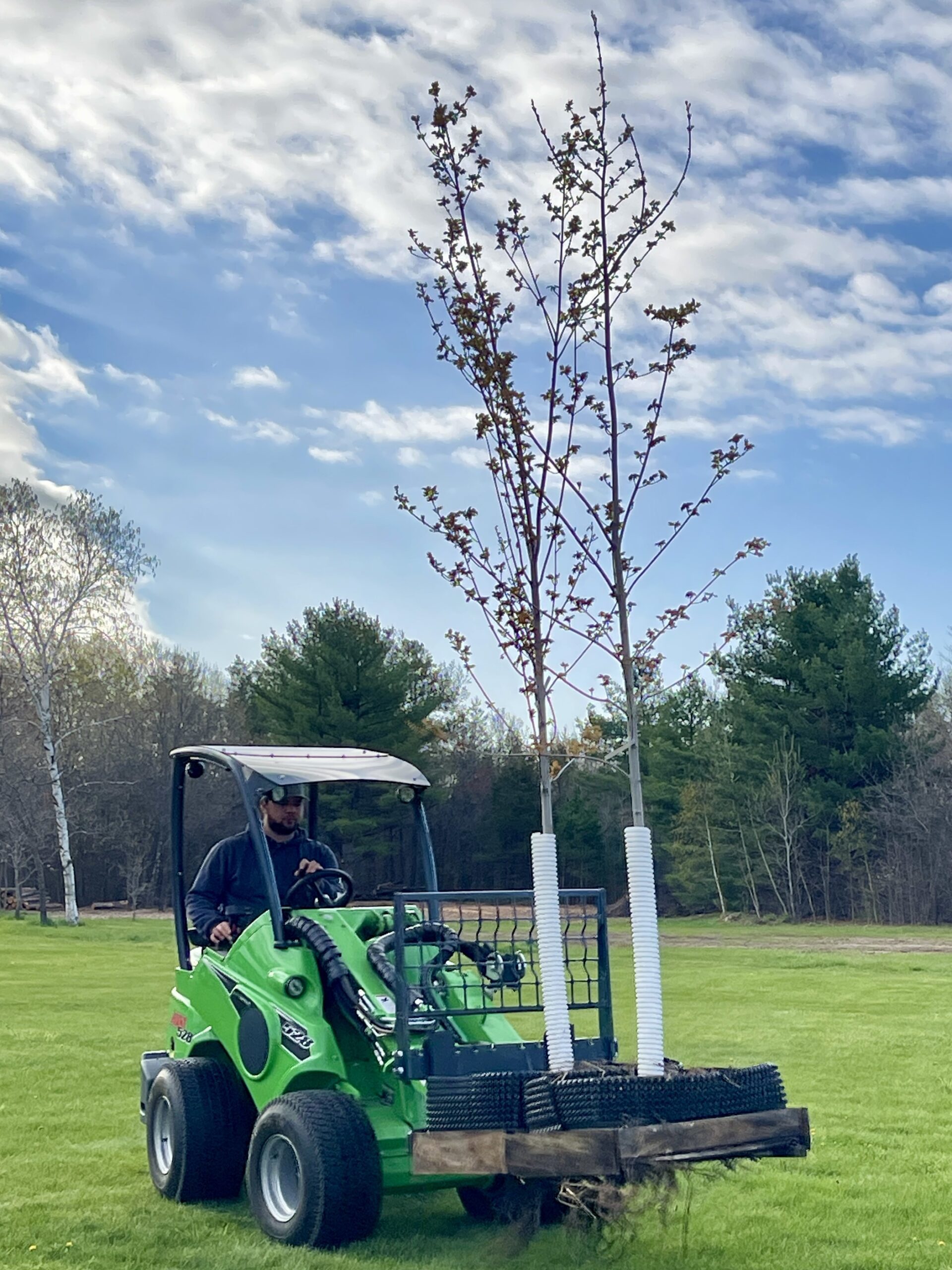
TREE PURCHASE INCLUDES
-
- Delivery to your site
- Professional planting
- mulch for root zone
- 1 year nursery warranty
Please call for pricing
Discount available when purchasing more than 1 tree
Option to upgrade nursery warranty to 5 years
Tree Size
Height Ranges
8′ to 14′
Caliper
1.5″ to 2.5″
Based on species
Tree Stewardship Program - Juvenile Tree Pruning
The goal of Juvenile Pruning is to facilitate proper structural development of the canopy. In the forest, trees typically do not retain any of their juvenile branches resulting in 20 or more feet of clear trunk. Our goal is to achieve 20 or more feet of clear trunk through strategic removal of all the juvenile branches. (For ornamental trees or screening trees, the clearance heights may be lower based on the location of the tree and the role it plays.) This is achieved with a minimum of three visits by our trained arborist staff within the first five years. This commitment to a juvenile training program following planting will ensure that your properly pruned trees will have the right structural branching. This investment in stewardship is the most critical step in establishing a mature urban forest tree post planting.
Root Structure
OUR TREES ROOT SYSTEM IS GROWN TO MIMIC HOW TREE ROOTS GROW IN THE FOREST – UNLIKE TRADITIONAL NURSERY PRODUCTION AND PLANTING PROCEDURES THAT IGNORE THIS CRITICAL MOMENT IN THE DEVELOPMENT OF THE ROOT SYSTEM. ROOTS ARE FORCED TO GROW WITHIN CONTAINERS THAT ARE NARROW AND DEEP. THIS IS DONE TO FACILITATE SHIPPING AND HANDLING RATHER THAN PROPER ROOT ORIENTATION FOR LONG TERM SURVIVAL.
Nearly every urban tree planted since World War II suffers from improper planting depth and root system problems resulting from standard nursery production practices. Those traditional practices result in stem girdling roots and basal trunk rot when the tree trunk is placed too deep into the soil during the final planting in the landscape.
OUR TREES ROOT SYSTEM ENCOURAGES NATURAL ROOT DEVELOPMENT AND DELIVERS AN UNDAMAGED ROOT SYSTEM THAT IS READY TO IMMEDIATELY COLONIZE TO YOUR PROPERTY. THE PRIMARY STRUCTURAL ROOTS OF THE TREE ARE SUPPOSED TO RADIATE FROM THE ROOT FLARE IN ALL DIRECTIONS.
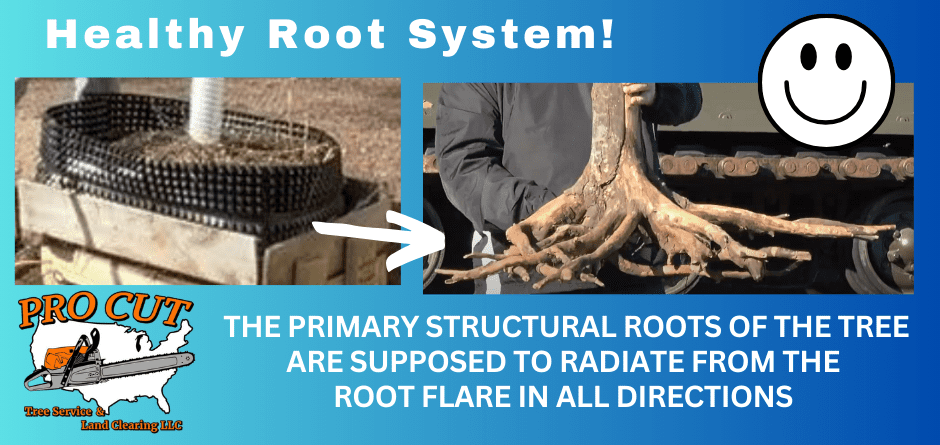

Our Tree Selection

The following new species are now available!
Deciduous Trees
Amur Maple Tree
Sugar Maple Tree
Hot Wings Maple Tree
Crimson Sunset Maple Tree
Prairie Horizon Alder Tree
Lustre Serviceberry Tree
Whitespire Birch Tree
Adirondack Crabapple
Sioxland Poplar
Quaking Aspen
Amur Chokecherry
Fruit Trees
Chestnut Crabapple Tree
Triumph Apple Tree
Cortland Apple Tree
Freedom Apple Tree
Gravenstein Apple Tree
Wodarz Apple Tree
Snowsweet Apple Tree
KinderKrisp Apple Tree
Zestar Apple Tree
Pattern Pear Tree
Early Gold Pear Tree
Golden Spice Pear Tree
Ure Pear Tree
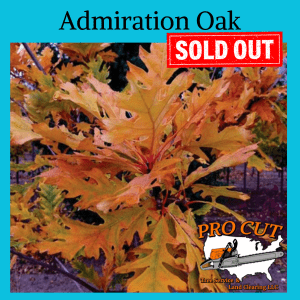
Admiration Oak
Type: Riparian Species
Height: 40′
Spread: 30′
Hardiness Zone: 2
Fall Color: Brown
Preferred Soil Type: Average to Moist, should not dry out
Exposure Type: Full Sun
The Admiration Oak is an extremely tough and adaptable oak making it a great choice for urban landscapes. The dense canopy and pyramidal form are more characteristics that help fit into yards. With a slower growth rate, you may have to wait for some shade but in the right conditions this tree should survive for 300 years.
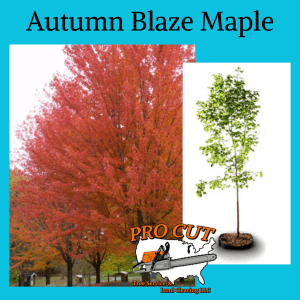
Autumn Blaze Maple
Type: Riparian Species
Height: 75′
Spread: 50′
Hardiness Zone: 3
Fall Color: Red Leaf
Preferred Soil Type: Wet and Dry Soils
Exposure Type: Full Sun
The Autumn Blaze Maple is well-known freemanii Maple has the iconic fiery red fall leaves and vigorous growth rate. It is one of the trees almost every person regardless of tree knowledge has heard of. Capable of putting on 5-6′ of growth a year as juvenile, aggressive pruning will be needed to maintain this tree as it begins to take off. Use this tree to bring rapid shade, beautiful fall color and a reliable tree.
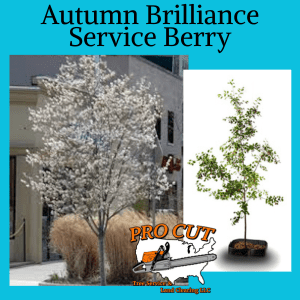
Autumn Brilliance Service Berry
Type: Ornamental Species
Height: 25’
Spread: 15’
Hardiness Zone: 3
Fall Color: Orange/Red
Flowers: White
Preferred Soil Type: Somewhat Dry to Wet
Exposure type: Full Sun to Full Shade
This tree has the double whammy with the earliest spring flowers in white before green up and spectacular orange/red fall color! This is a gorgeous ornamental tree that can be planted in sun or shade which is very unusual for a flowering tree.
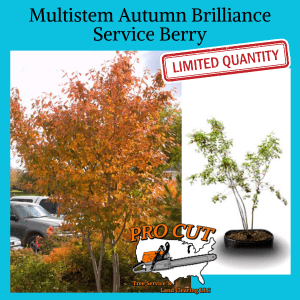
Autumn Brilliance Service Berry – MultiStem
Type: Ornamental Species
Height: 25’
Spread: 15’
Hardiness Zone 3
Fall Color: Orange/Red
Flowers: White Persistent Fruit
Preferred Soil Type: Somewhat Dry to Wet
Exposure type: Full Sun to Full Shade
A versatile understory tree with lots of year-round appeal. The multistem version can provide good screening or boarders for neighbors. The early April flowers add a lot of beauty to the landscape and the berries in June provide food for habitat. Then, in the fall it shows off its namesake with brilliant orange/red color. This cultivar reportedly has excellent disease resistance.
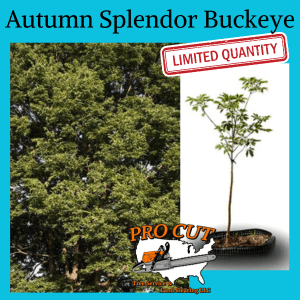
Autumn Splendor Buckeye
Height: 35’
Spread: 30’
Hardiness Zone: 3
Fall Color: Scarlet Orange to Maroon
Flowers: Creamy Yellow
Preferred Soil Type: Average to Moist Conditions
Exposure type: Full Sun to Partial Shade
Autumn Splendor Buckeye is a great accent tree with phenomenal fall color and creamy yellow flowers in the spring. Autumn Splendor is not bothered by insects or diseases. It is notably resistant to leaf scorch that other buckeye and horse chestnut species are susceptible to. The fruits produced by Autumn Splendor Buckeye are toxic to humans and pets.
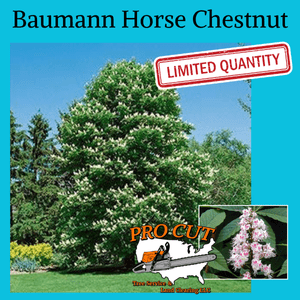
Baumann Horse Chestnut
Height: 40’
Spread: 40’
Hardiness Zone 4
Fall Color: Yellow
Preferred Soil Type: Average to Moist Conditions
Exposure type: Full Sun to Partial Shade
The Baumann Horse Chestnut is a double-flowered cultivar that produces no nuts. Baumann Horse Chestnut features bold spikes of white flowers with brick red centers rising above the foliage in mid Spring. This tree is prone to leaf scorch and a fungal leaf blotch. Horse Chestnuts are suited for use as an urban shade tree, particularly in parks or gardens.

Blue Beech
Height: 30′ – 35′
Spread: 20′ – 35′
Hardiness Zone 3
Fall Color: Orange to Red
Preferred Soil Type: Moist, Well Drained Soil
Exposure type: Full Sun to Full Shade
The Blue Beech tree also known as American Hornbeam and musclewood, is a small shrubby tree with one or more trunks. This tree has distinct flares on the trunk and branches that resemble muscle definition. There are no known major diseases or insects that affect blue beech. Blue beech provides food and shelter for game birds such as grouse and pheasants, small mammals, and songbirds. Deer are also known to browse the twigs and foliage.
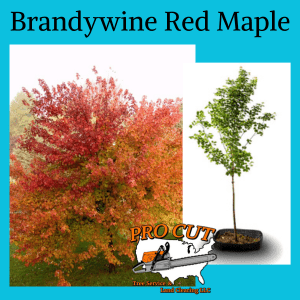
Brandywine Red Maple
Type: Upland Species
Height: 50′
Spread: 35′
Hardiness Zone 4
Fall Color: Vibrant Red
Preferred Soil Type: Wet or Dry, cool root system
Exposure type: Full sun to partial shade
This red maple offers solid branch structure and a moderate growth rate. It has vibrant red fall color hence the Brandywine cultivar name.

Bur Oak
Height: 60′ – 80′
Spread: 60′ – 80′
Hardiness Zone 3 to 8
Fall Color: Brown
Preferred Soil Type: Alkaline Soil, Dry to Moist
Exposure type: Full Sun
Discover the enduring allure of the Bur Oak, a choice embraced for its resilience and grandeur. With its robust trunk and expansive canopy, it provides abundant shade and habitat for wildlife, enriching any landscape. Pruning should be done in the dormant season to prevent attracting beetles that are potentially carrying oak wilt and to prevent further spread of the fungal pathogen that causes bur oak blight.
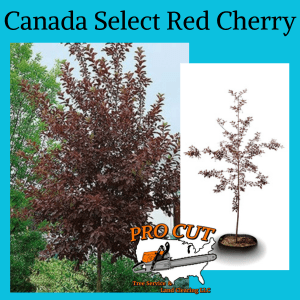
Canada Select Red Cherry
Height: 20′-30′
Spread: 15′-20′
Hardiness Zone 2 to 7
Flower Color: White Fall Color: Intense Purple/Red
Preferred Soil Type: Dry to Medium Loams
Exposure type: Full Sun to Partial Shade
Introducing Canada Select Red Cherry, the versatile and elegant chokecherry tree. Embrace its ornamental beauty and ecological benefits in your landscape. Beautiful flowers in the Spring, fruit for wildlife in the summer, and intense fall color make this a fantastic tree year-round. Chokecherry is a good food source for wildlife and birds, and the flowers attract pollinators in the Spring.
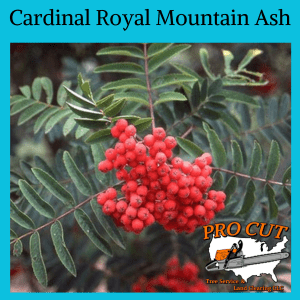
Cardinal Royal Mountain Ash
Height: 35′
Spread: 20′
Hardiness Zone 3 to 6
Fall Color: Rust
Preferred Soil Type: Acidic, Moist, Well Drained
Exposure type: Full Sun
The Cardinal Royal Mountain Ash is a slightly more upright cultivar of the European Mountain Ash. It has dark green leaves with silvery undersides, white flowers in spring, and bright red berries in fall, this tree offers all the same great year-round features that are loved about the mountain ash. It can be used as a shade tree, vertical landscape accent, or street tree.
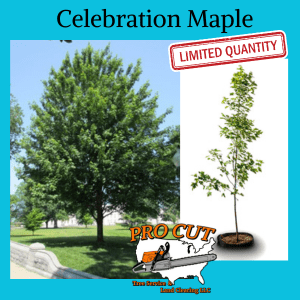
Celebration Maple
Height: 40′ – 50′
Spread: 20′ – 35′
Hardiness Zone 4
Fall Color: Golden Yellow with Red
Preferred Soil Type: Well-drained, moist, slightly acidic, loamy soils; adapts to many types of soils
Exposure Type: Full Sun to Partial Shade
The Celebration Maple is another freemanii introduction and has a classic upright form with uniform growth, making for a great specimen tree in the landscape. This tree, like most Freeman hybrids, grows fast and is also known for its fall color. In early October, it becomes a brilliant red and then slowly changes to gold by late October. The growth in a well-watered environment will require regular pruning to prevent codominant branches. It possesses a better structure than Autumn Blaze® Maple with more open branch angles and a better-defined central leader.
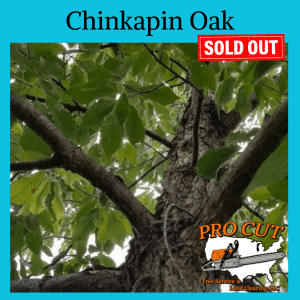
Chinkapin Oak
Height: 50′ – 80′
Spread: 50′ – 70′
Hardiness Zone 5 to 7
Fall Color: Golden Yellow to Orange-Brown to Brown
Preferred Soil Type: Alkaline soil, Moist, Well-Drained
Exposure Type: Full Sun
Chinkapin oak is native to the Midwest, where it is often found as a specimen tree. Young trees retain a pyramidal to oval habit with a pale gray, scaly ridged central trunk. As trees age, the crown becomes more rounded. This resilient white oak can be a champion for the urban landscape where it can handle various site conditions. Oak wilt and two-lined chestnut borer can be problems for this tree, especially as a juvenile.
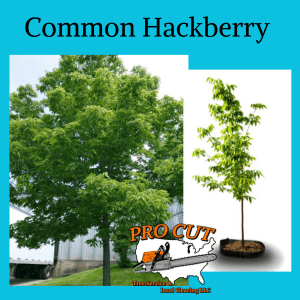
Common Hackberry
Type: Riparian Species
Height: 75’
Spread: 50’
Hardiness Zone 2
Fall Color: Soft Yellow
Preferred Soil Type: Wet to Dry
Exposure Type: Full Sun to Partial Shade
Celtis Occidentalis – Common Hackberry
The Common Hackberry is an excellent urban tree that has replaced the American Elm in many communities where Elms were previously the dominant tree of the urban canopy. A moderately growing species, this tree has ridged juvenile bark and large spade like leaves. This tree has been a trooper and can handle wet and dry conditions. Growing to a large size at maturity it can do a tremendous amount for the urban canopy and is a go to for highly urban environments such as sidewalk cutouts and parks.
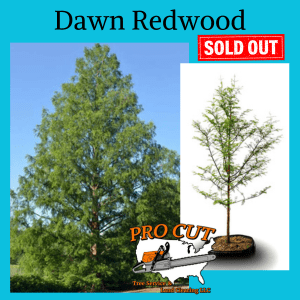
Dawn Redwood
Height: 70′ – 100′
Spread: 25′
Hardiness Zone 4 to 8
Fall Color: Russet Brown
Preferred Soil Type: Acid soil, Moist, Well Drained
Exposure Type: Full Sun
From fossil records, Dawn Redwood is known to have existed as many as 50 million years ago. Dawn Redwood is a deciduous, coniferous tree that grows in a conical shape up to 100’ tall. It is related to and closely resembles bald cypress (Taxodium) and redwood (Sequoia). The fern-like feathery foliage emerges light green in spring, changing to dark green in summer, then a russet brown in autumn.
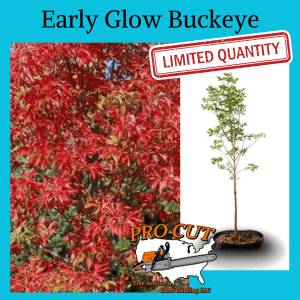
Early Glow Buckeye
Height: 20′ – 40′
Spread: 20′ – 40′
Hardiness Zone 3 to 7
Fall Color: Bright Red
Preferred Soil Type: Acid soil, Moist, Well Drained
Exposure Type: Full Sun to Partial Shade
The Early Glow Buckeye is a cultivar with superior resistance to leaf blotch, leaf scorch and powdery mildew. Reliable red fall color and low fruit production. The large, upright, and most of all, beautiful flower clusters of Early Glow Buckeye are a treat to hummingbirds and are sure to attract many guests in spring. Early Glow Buckeye produces very few nuts, but they can be toxic to livestock.
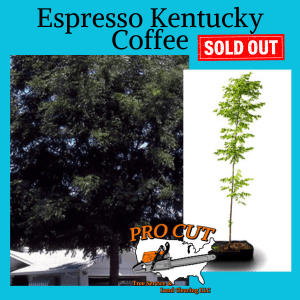
Espresso Kentucky Coffee
Type: Riparian Species
Height: 60′
Spread: 40’
Fall Color: Yellow
Preferred Soil Type: Dry to Partially Wet
Exposure Type: Full Sun
This is a very interesting tree with compound leaves much like the Honeylocust. It has furrowed bark and interesting canopy architecture with distinct branch angles. A seedless variety with a slow growth habit that excels in full sun but can also be very vigorous in planting situations where it only receives full sun for part of the day. It is slow to branch out as a juvenile where it arrives as a branchless whip. By growing season 3, it should be starting to add branches and structure quickly. It can sometimes be late to break bud but will quickly become one of the more interesting trees on their property.
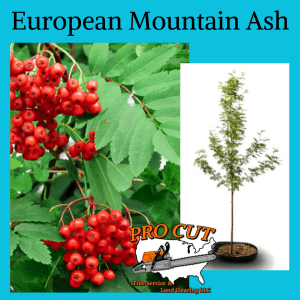
European Mountain Ash
Height: 20′ – 30′
Spread: 20’ – 25′
Hardiness Zone: 3 to 7
Fall Color: Red
Preferred Soil Type: Prefers Well Drained, Moist, Loamy, Adapts to many types of soil
Exposure Type: Full Sun
European Mountain Ash is not a true ash tree. It does not belong to the genus Fraxinus, in fact it belongs to the genera Sorbus and is native throughout Europe. This tree is primarily used as a small landscape tree or for wildlife food plots as animals love the fruit this tree bears. This tree has an oval shape and will have a moderately dense canopy. This tree blossoms beautiful white flowers in the spring that complement the bright red fruit on the tree that birds and other wildlife love. This fruit is persistent so it will stay on the tree until temperatures cool in the fall.
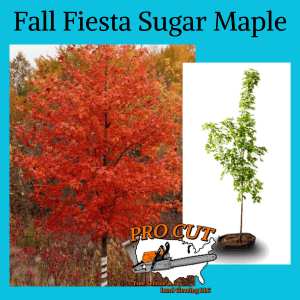
Fall Fiesta Sugar Maple
Height: 75’
Spread: 50’
Hardiness Zone 3
Fall Color: Orange
Preferred Soil Type: Well drained fertile soil
Exposure Type: Full/Partial Shade
The Fall Fiesta Sugar Maple is Wisconsin’s State tree with a robust yellow to orange fall color. A large statured maple that is fast growing compared to other sugar maple varieties. Dark green summer foliage with high leaf density.
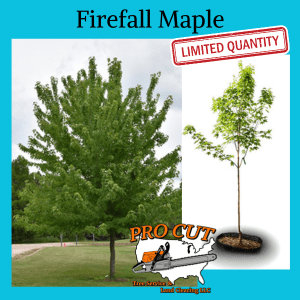
Firefall Maple
Height: 50’
Spread: 35’
Hardiness Zone 4
Fall Color: Orange
Preferred Soil Type: Average to Wet
Exposure Type: Full Sun
The Firefall is another freemanii, a silver maple/red maple hybrid with an upright growth form. Firefall Maple, known for its outstanding shades of orange in the autumn, can grow at significant rates and under ideal conditions lives for 80 years or more. Its slightly smaller mature size makes it an ideal tree for smaller properties. The blend of size, beauty, and growth rate make this a fantastic option for the urban landscape.
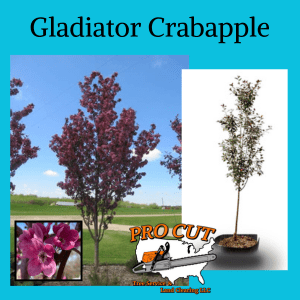
Gladiator Crabapple
Type: Ornamental Species
Height: 20′
Spread: 10’
Flowers: Pink Persistent Fruit
Preferred Soil Type: Dry to Partially wet
Exposure Type: Full Sun
The stems and leaves are a magnificent purple that is hard to describe. The flowers are pink in May and the persistent fruit attracts all kinds of pollinators and wildlife to these trees! This tree is disease resistant.

Heritage River Birch
Height: 30′ – 40′
Spread: 20′ – 30′
Hardiness Zone 4 – 9
Fall Color: Buttery Yellow
Preferred Soil Type: Acid soil, Moist well drained soil, Wet soil
Exposure Type: Full Sun
The Heritage River Birch is a vigorous, fast-growing, medium-sized tree. As a single trunk tree, it develops a pyramidal habit when young, but matures to a more rounded shape. River birch is drought sensitive and does not like hot, dry summers. Heritage has larger, glossy, dark green leaves with nearly white interior peeling bark, this cultivar is more heat tolerant.
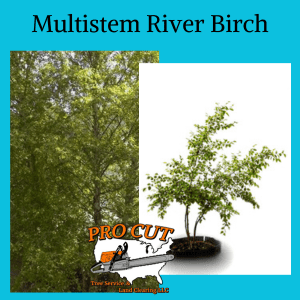
MultiStem River Birch
Height: 40′ – 60
Spread: 40′ – 60′
Hardiness Zone 3 – 7
Fall Color: Yellow
Preferred Soil Type: Moist to Wet
Exposure Type: Full Sun
A large and beautiful tree prized for its highly textural, colorful, and peeling bark. Multi-trunked trees form a more irregular crown and are considered the superior growth habit for this species. This versatile, highly heat tolerant tree thrives in riparian settings with high water tables and problematic low wet soils yet adapts to mild drought when established.
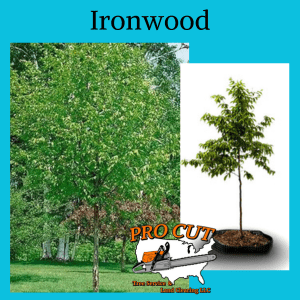
Ironwood
Height: 50′
Spread: 25′
Hardiness Zone 3
Fall Color: Yellow
Preferred Soil Type: Adapts well to most soil types, Moist, Well Drained
Exposure Type: Full Sun to Full Shade
This tree is another addition to our Full Shade understory toolbox. Preferring a little more sun than the other members of this group it nonetheless can perform in high shade planting environments. Larger than the blue beech but very similar and often confused with one another. This tree can be a large addition to screening situations in the full shade when properly maintained by an arborist.
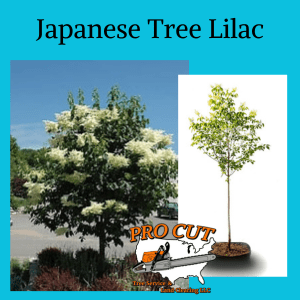
Japanese Tree Lilac
Type: Ornamental Species
Height: 25′
Spread: 25′
Flowers: White
Preferred Soil Type: Wet and Dry
Exposure Type: Full sun preferred
The Japanese Tree Lilac’s white flowers pop in June. The leaves are dark green with shiny bark and pronounced lenticles for added character year round. Moderate juvenile growth rate.
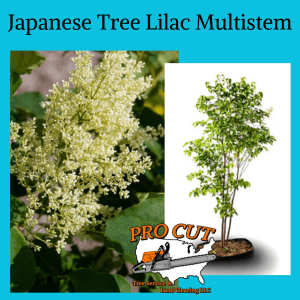
Japanese Tree Lilac MultiStem
Height: 15 – 25′
Spread: 10 – 15′
Flowers: White
Preferred Soil Type: Moist, Well Drained
Exposure Type: Full Sun
Its best ornamental feature is its showy, fragrant, creamy white flowers which bloom in upright panicles to 12” long in late spring to early summer. (After other lilac species) The later bloom makes it a great addition to a row of flowering crabs ensuring a client has flowering trees well into the summer. Flowers at an early age and flowers very prolifically. Good resistance to powdery mildew, scale insects, and borers.
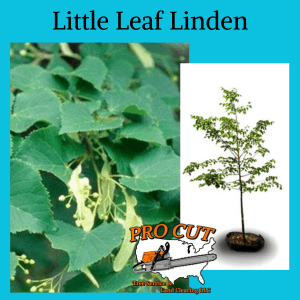
Little Leaf Linden
Height: 50′-70′
Spread: 35’-50′
Fall Color: Gold/Yellow
Preferred Soil Type: Moist, Well Drained
Exposure Type: Full Sun
It has shiny dark green leaves that turn a golden yellow in fall, and in summer it has dangling, fragrant pale-yellow flowers. Used widely by insect pollinators, a favorite of honeybees, and as a habitat for birds and mammals. Watch for aphids and Japanese beetles as they can be a problem. Little Leaf Linden is tolerant of pollution common to the urban landscape.
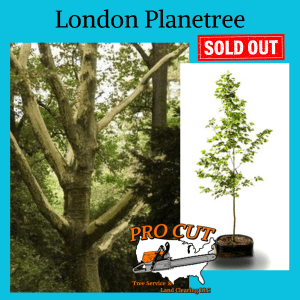
London Planetree
Height: 55′-65′
Spread: 40’-50′
Fall Color: Yellow and Brown
Preferred Soil Type: Moist, Well Drained
Exposure Type: Full Sun
The London planetree, is a hybrid cross between American sycamore and Oriental planetree. Resistant to anthracnose and frost cracking. The signature ornamental feature of this huge tree is its brown bark which exfoliates in irregular pieces to reveal creamy white inner bark. Mature trees typically display mottled white bark that facilitates identification from great distances. This tree, once mature, is the definition of statement tree with it’s combination of size and beauty.
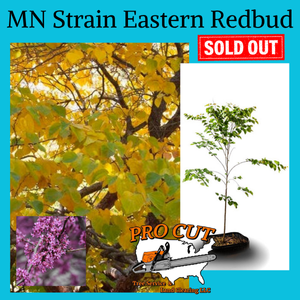
MN Strain Eastern Redbud
Height: 20′ – 30′
Spread: 25′ – 35′
Flower Color: Pink/Purple
Fall Color: Buttery Yellow
Preferred Soil Type: Moist, well-drained soil
Exposure Type: Partial to Full Sun
The Redbud is a small tree reaching 25 to 30 feet high and wide. It is particularly noted for its stunning pea-like rose purple flowers which bloom profusely on bare branches in early spring. The flowers provide an early-season nectar source for hummingbirds. The seeds and flower buds are eaten by songbirds.
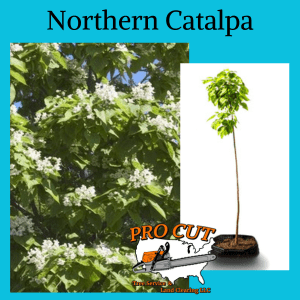
Northern Catalpa
Height: 40′ – 70′
Spread: 20′ – 50′
Fall Color: Yellow
Preferred Soil Type: Alkaline soil, Moist, well-drained soil
Exposure Type: Full Sun
The northern catalpa is a large, upright tree. Its bark is a gray brown that becomes scaly with age. Leaves are simple and large, 6″ to 10″ long, and heart shaped. Northern catalpa has large showy flowers that are upright in 4″ to 8″ clusters. The flowers are white, bell-shaped flowers with orange stripes and purple spots and stripes. No serious insect or disease problems. A super resilient and beautiful tree that has great potential to be a great shade and ornamental tree.
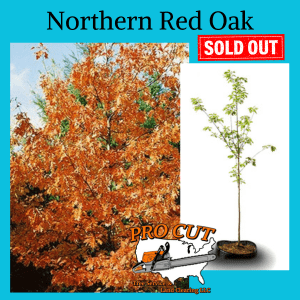
Northern Red Oak
Height: 60′ – 75′
Spread: 60′ – 75′
Fall Color: Russet-Red to Bright Red
Preferred Soil Type: Acid, Moist, Well Drained
Exposure Type: Full Sun to Partial Shade
The Northern Red Oak is one of the faster growing oaks. They grow tall and straight with a clear trunk and narrow crown. The leaves are handsome throughout the year, emerging pinkish red, turning lustrous dark green in summer, and changing to russet-red to bright red in autumn. A great tool for enhancing the wildlife in an area with a food source and shelter in a hurry, compared to other oak species.
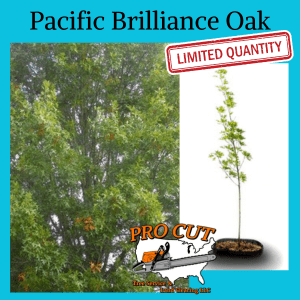
Pacific Brilliance Oak
Height: 40′ – 50′
Spread: 20′ – 35′
Fall Color: Orange, Red, Yellow
Preferred Soil Type: Prefers Moist to Wet, Acidic, Loamy
Exposure Type: Full Sun
Best known for its terrific fall color, the canopy of the Pacific Brilliance Pin Oak forms an attractive, pyramidal form of upward sweeping branches. It is a useful tree to grow in urban settings where it can be planted as a street tree. It is also useful in narrow areas as its slim canopy easily fits into small landscapes, providing a vertical accent. It won’t produce as many acorns as typical oaks, which can be a pro or con depending on your desire.
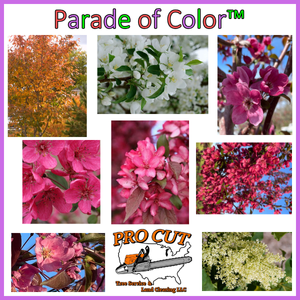
Parade of Color
Do you want to transform your space? Are you ready to add some color to your property?
Create a statement in your yard with a line of trees that provides 6 weeks of vibrant spring color to kickstart your summer!
Starting in late April into June. Kick off with the Autumn Brilliance Serviceberry, then add your favorite crabapple or two and finish it up with the Snowcap Japanese Tree Lilac. You create the masterpiece starting with a minimum of three trees!
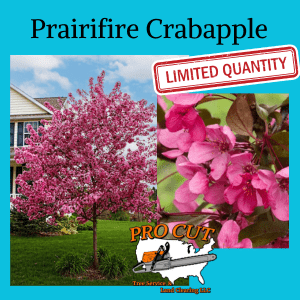
Prairifire Crabapple
Type: Ornamental Species
Height: 15′-20′
Spread: 15′
Flowers: Pink
Persistent Fruit
Preferred Soil Type: Well drained/Acidic
Exposure Type: Full sun
This crabapple is a particularly disease resistant and grows well in many conditions. It does not drop its fruit making it a low maintenance tree. Coupled with its later blooming pink flowers, it keeps the appeal going later into the year for the flowering season.
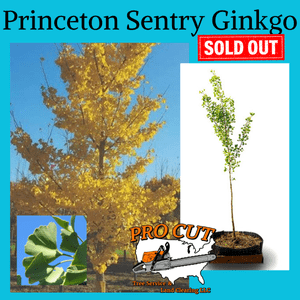
Princeton Sentry Ginkgo
Height: 40′-50′
Spread: 20′-30′
Fall Color: Golden Yellow
Preferred Soil Type: Moist, Well Drained.
Exposure Type: Full Sun
This tree is a piece of living history, this slow growing cultivar makes a great option for the urban canopy. ‘Princeton Sentry’ is an all-male cultivar typically growing at maturity to 40-50′ with an upright, narrowly conical habit. A resilient tree that will adapt to most soil conditions also has no serious insect or disease problems. The upright form, resiliency, and beautiful fall color create a perfect combination for an urban tree.
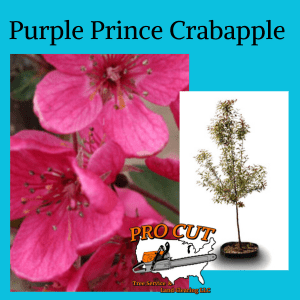
Purple Prince Crabapple
Type: Ornamental
Height: 20′
Spread: 20′
Flowers: Red/Purple Persistent Fruit
Preferred Soil Type: Dry to wet, but not persistently wet
Exposure Type: Full Sun
May brings red/purple flowers covering the entire canopy. Purple/green sumer leaves follow that up all summer. Very disease resistant while also having persistent fruit that will attract wildlife without the mess.
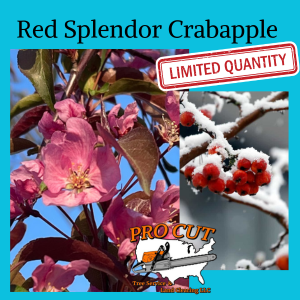
Red Splendor Crabapple
Type: Ornamental
Height: 20-25′
Spread: 20′
Flowers: Pink Persistent Fruit
Preferred Soil Type: Dry to wet but not persistently wet
Exposure Type: Full Sun
Red Splendor Crabapple is known for its glossy green leaves, persistent fruit, and pink flowers. This tree will give contrast and color in multiple seasons.
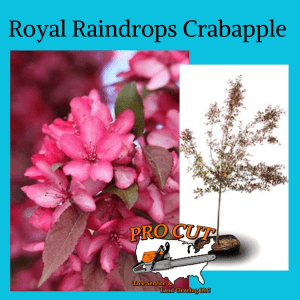
Royal Raindrops Crabapple
Type: Ornamental
Height: 20’
Spread: 15’
Preferred Soil Type: Slightly acidic / well-drained
Exposure Type: Full Sun
This crabapple is known for its vibrant red summer leaf color. Distinct even amongst other similar red leafed crabapples such as the gladiator or purple prince. Resistant to fireblight.
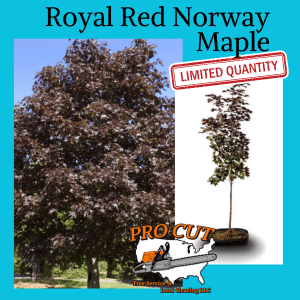
Royal Red Norway Maple
Type: Upland Species
Height: 50′
Spread: 35’
Hardiness Zone 4
Fall Color: Brown
Preferred Soil Type: Any soil as long as it’s not too wet
Exposure Type: Full Sun to Partial Shade
This trees dark maroon to purple leaves will stick out next to the blue sky or other green trees nearby. This tree competes in both sandy and clay environments. What makes this tree excel is its adaptiveness to different soil environments. This tree as a juvenile is susceptible to tip dieback when winters are mild and rainy. This tree will sometimes will require reduction of the central leader.
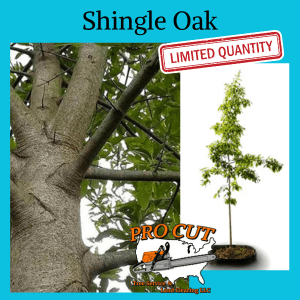
Shingle Oak
Type: Riparian Species
Height: 60′
Spread: 30’
Hardiness Zone 5
Fall Color: Bright Red
Preferred Soil Type: Wet, preferably not always wet
Exposure Type: Full Sun
This member of the Red Oak family has a very distinct smooth metallic bark as a juvenile. It has a glossy smooth-edged leaf which is different from most oak species. This tree is not nearly as spreading as other oaks and will fit better in narrow planting spaces for large trees. A reliable tree with a moderate growth rate. This tree thrives in Wisconsin despite its hardiness zone.
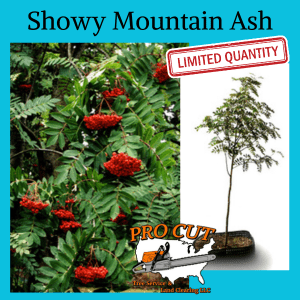
Showy Mountain Ash
Height: 20′ – 30′
Spread: 15′ – 20’
Hardiness Zone 2 to 6
Fall Color: Yellow/Red
Preferred Soil Type: Acidic, Moist, Well Drained
Exposure Type: Full Sun
Although it is not in the ash family (Fraxinus), the common name Showy Mountain Ash is due to its leaves which look like ash leaves. This smaller deciduous tree features beautiful white flowers in the spring, red fruit in late summer, and good fall color making it an appealing tree year-round. This tree is good for bringing birds to the landscape. Birds and small mammals will eat the fruits.
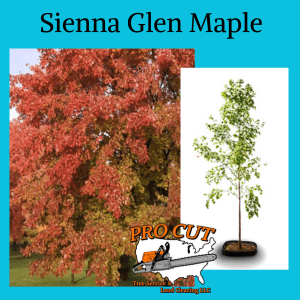
Sienna Glen Maple
Type: Riparian Species
Height: 75′
Spread: 50′
Hardiness Zone 3
Fall Color: Red to Orange Leaf
Preferred Soil Type: Dry to Wet Soils
Exposure Type: Full sun to partial shade
The Sienna Glen Maple is another freemanii introduction that offers some slight differences from the Autumn Blaze. The largest difference between this tree and the Autumn Blaze is that Sienna Glen has better branch angles. This tree will need aggressive maintenance when it takes off because it is still a freemanii. It has a more orange hued fall leaf than the Autumn Blaze. To sum up the Sienna Glen, it’s a better cultivar than Autumn Blaze when it comes to branch angles with a very slightly less vigorous growth rate and an equally beautiful fall color that has a little more orange to it than Autumn Blaze.
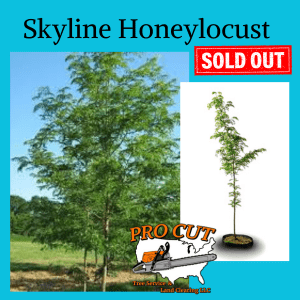
Skyline Honeylocust
Type: Upland Species
Height: 50′
Spread: 40′
Hardiness Zone 4
Fall Color: Yellow Leaf
Preferred Soil Type: Wet and Dry
Exposure Type: Full sun
The Skyline Honeylocust is a beautiful shade tree with a moderate growth rate. This tree is one of the champions of high urban environments. Offering high pollution resistance and salt tolerance much like the hackberry, it is a common member of boulevard plantings and sidewalk cutouts. It is a thornless and fruitless cultivar which provides filtered shade that can cool a site without shading out turf grass. At maturity interior branches get shaded out so it will require an arborist to clean up the interior canopy as it reaches a mature size periodically.
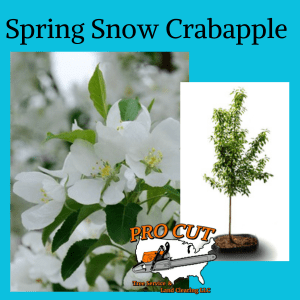
Spring Snow Crabapple
Type: Ornamental
Height: 25’-30’
Spread: 15’
Flowers: White
Preferred Soil Type: Dry to partially wet
Exposure type: Full Sun
May brings white flowers covering the entire canopy of the Spring Snow Crabapple. This is a sterile cultivar which means it flowers but does not form fruit so for the gotta have it neat and tidy crowd, they will love this tree! A fast grower and very disease resistant.
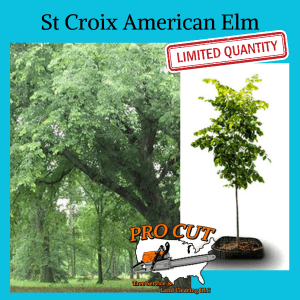
St Croix American Elm
Height: 60′ – 75′
Spread: 60′ – 90′
Hardiness Zone: 3 to 6
Fall Color: Yellow
Preferred Soil Type: Moist, Well Drained
Exposure Type: Full Sun
This unique cultivar stands as a beacon of hope and resilience in the face of adversity. Bred for its increased resistance to Dutch Elm Disease, the St Croix™ combines the classic elegance and form of the traditional American Elm with the hardiness required for today’s environment. Its robust health and stunning aesthetic qualities make it a prime choice for urban planting.
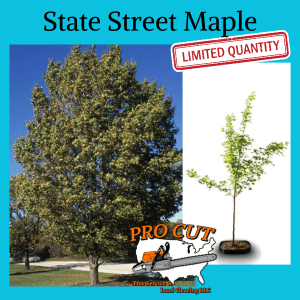
State Street Maple
Height: 40′ – 45′
Spread: 30′ – 35′
Fall Color: Pale Golden Yellow
Preferred Soil Type: Moist, well-drained soil
Exposure Type: Full Sun to Partial Shade
This maple has a mature oval, round, upright form. It is more densely branched than other maples which makes it an excellent shade tree. The handsome, corky bark develops vertical scales with age. It has excellent heat and drought tolerance, as well as tolerance of alkaline soils and salt spray.
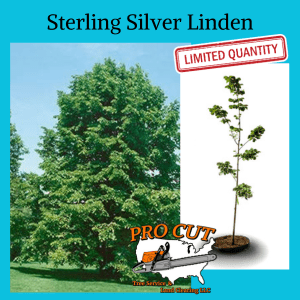
Sterling Silver Linden
Height: 50′ – 70′
Spread: 25′ – 40′
Hardiness Zone: 4 to 7
Fall Color: Mild Yellow
Preferred Soil Type: Moist, Well Drained
Exposure Type: Full Sun to Partial Shade
Sterling Silver Linden has leaves that are dark green above and silvery-white below. It can be used as a street tree. The fragrant flowers that bloom in late spring or early summer are very attractive to pollinators. It has good tolerance of heat and drought. This cultivar shows some resistance to Japanese beetle.
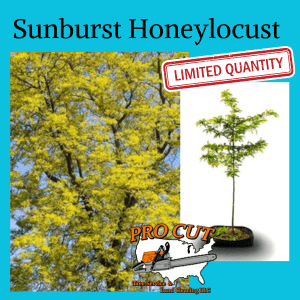
Sunburst Honeylocust
Type: Upland Species
Height: 35′
Spread: 35′
Hardiness Zone 4
Fall Color: Yellow Leaf
Preferred Soil Type: Wet or Dry/ Acidic or Alkaline
Exposure Type: Full Sun
Another Honeylocust cultivar that is an urban trooper. It is a medium sized variety allowing it to fit in tighter spaces than Skyline Honeylocust. The main draw of this tree is its vibrant yellow leaves. As a juvenile this yellow leaf will be all summer long. As this tree reaches maturity it will start the year yellow but during the summer will eventually transition back to green leaves.
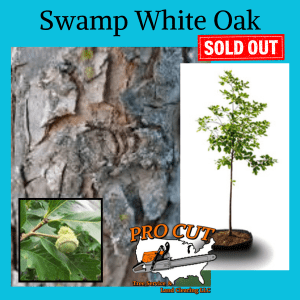
Swamp White Oak
Type: Riparian Species
Height: 50’-60’
Spread: 40’-50’
Hardiness Zone 3
Fall Color: Burnt Orange
Preferred Soil Type: Wet or dry, preferably not dry sand
Exposure type: Full sun
A riparian oak that is very popular in our urban forests. It has a fairly open canopy with big burly branches that tend to extend horizontally forever! This one grows much faster than Quercus alba – the white oak. The bark exfoliates on the branches for a unique color especially when the sun hits it during the sunrise.
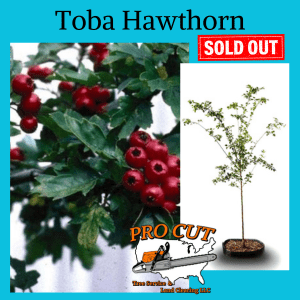
Toba Hawthorn
Type: Ornamental
Height: 15’ – 20’
Spread: 15’ – 20’
Flowers: Pink
Preferred Soil Type: Moist to Dry, Well Drained.
Exposure type: Full Sun
The Toba Hawthorn is the hardiest of the ornamental hawthorns, the perfect accent for small home landscapes; smothered in pink flowers in spring followed by showy red berries in fall. It develops an interesting, twisted trunk with time; thorns can be quite sharp.
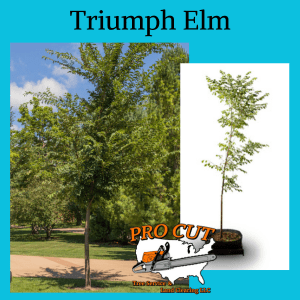
Triumph Elm
Type: Riparian Species
Hardiness Zone 4
Height: 60′
Spread: 60′
Fall Color: Yellow
Preferred Soil Type: Wet or Dry
Exposure Type: Full sun
The Triumph Elm is a beautiful hybrid elm with a vigorous growth rate. Under ideal conditions with ample soil moisture it can add 6 feet of growth per year as juvenile. Requires frequent stewardship pruning to train this tree into maturity. Due to this cultivars form and twisted grain wood branch breakage usually results in branch hinging instead of breaking completely off. This makes it a safer selection than some other species of its size.
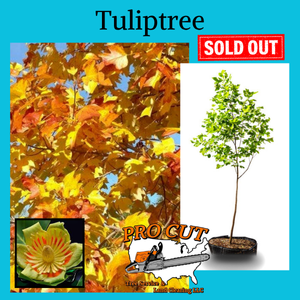
Tuliptree
Height: 60′-90′
Spread: 30′-50′
Fall Color: Golden Yellow
Preferred Soil Type: Moise, Well Drained, Slightly Acidic Tolerant of Alkaline Soils
Exposure Type: Full Sun/Partial Shade
Tuliptree is named and noted for its cup-shaped, tulip-like flowers that bloom in spring. It has showy flowers that are yellow with an orange band at the base of each petal. Flowers of the tuliptree are used by insect pollinators. The tree is also a good habitat and food source for Sapsuckers, Songbirds, and small mammals. The tuliptree is fast-growing and somewhat weak wooded, making them susceptible to limb breakage in high winds or from ice/snow.
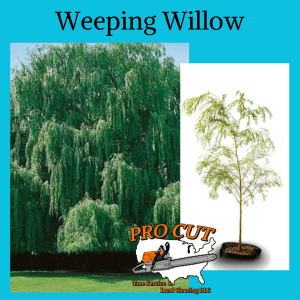
Weeping Willow
Type: Riparian Species
Height: 50′
Spread: 50′
Hardiness Zone 4
Preferred Soil Type: Wet
Exposure Type: Full Sun
This is the classic weeping willow. Growing as wide as it is tall with large dropping branch structure it is a beautiful landscape specimen. As a juvenile it has distinctly smooth yellow bark which transitions to scaly ridged bark in maturity. A fast growing tree with a vigorous root system it must have full sun to succeed. It can also be used to help with drainage in low spots were water collects as it can pull lots of water out of the soil in maturity as a riparian tree. It looks great along water features and as a landscape tree standing alone.
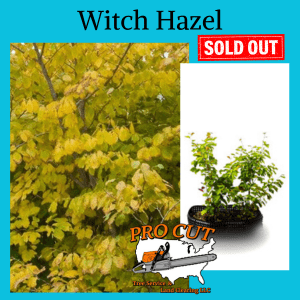
Witch Hazel Shrub
Height: 15′-25′
Spread: 15′-20′
Hardiness Zone 3 to 8
Fall Color: Yellow
Preferred Soil Type: Moist, Well Drained
Exposure Type: Full Sun to Full Shade
The witch hazel is a fall-blooming, deciduous multi-stemmed shrub. They are green in the summer, turning yellow in the fall. This plant can be used for shrub bordering, screening, and hedging. The seeds are eaten by several species of birds. It also serves as a host plant for the larvae of the spring azure butterfly.
